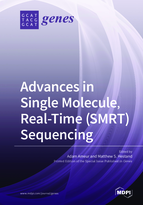Advances in Single Molecule, Real-Time (SMRT) Sequencing
A special issue of Genes (ISSN 2073-4425). This special issue belongs to the section "Technologies and Resources for Genetics".
Deadline for manuscript submissions: closed (31 January 2019) | Viewed by 71026
Special Issue Editors
Interests: next-generation sequencing; single-molecule sequencing; clinical sequencing; bioinformatics; genomics
Special Issues, Collections and Topics in MDPI journals
2. Department of Pediatrics, University of Cincinnati, 2600 Clifton Ave, Cincinnati, OH 45220, USA
Interests: next-generation sequencing; single-molecule sequencing; clinical sequencing; bioinformatics; 22q11 deletion syndrome
Special Issue Information
Dear Colleagues,
PacBio’s single molecule, real-time (SMRT) sequencing technology offers important advantages over the short-read DNA sequencing technologies that currently dominate the market. This includes exceptionally long read lengths (20 kb or more), unparalleled consensus accuracy, and the ability to sequence native, non-amplified DNA molecules. From microbes to vertebrates, long reads are now used to create highly accurate de novo genome assemblies, characterize complex structural variations, permit full-length RNA isoform sequencing, and directly phase variants. The high accuracy further enables low frequency mutation detection and clonal evolution determination. Besides reducing biases, sequencing native DNA also permits the direct measurement of DNA base modifications. Therefore, SMRT sequencing has become an attractive technology in many fields, such as agriculture, basic science, and medical research. The boundaries of SMRT sequencing are being continuously pushed by developments in bioinformatics and sample preparation.
This Special Issue is a collection of articles showcasing the latest developments and the breadth of applications enabled by SMRT sequencing technology.
Dr. Adam Ameur
Dr. Matthew S. Hestand
Guest Editors
Manuscript Submission Information
Manuscripts should be submitted online at www.mdpi.com by registering and logging in to this website. Once you are registered, click here to go to the submission form. Manuscripts can be submitted until the deadline. All submissions that pass pre-check are peer-reviewed. Accepted papers will be published continuously in the journal (as soon as accepted) and will be listed together on the special issue website. Research articles, review articles as well as short communications are invited. For planned papers, a title and short abstract (about 100 words) can be sent to the Editorial Office for announcement on this website.
Submitted manuscripts should not have been published previously, nor be under consideration for publication elsewhere (except conference proceedings papers). All manuscripts are thoroughly refereed through a single-blind peer-review process. A guide for authors and other relevant information for submission of manuscripts is available on the Instructions for Authors page. Genes is an international peer-reviewed open access monthly journal published by MDPI.
Please visit the Instructions for Authors page before submitting a manuscript. The Article Processing Charge (APC) for publication in this open access journal is 2600 CHF (Swiss Francs). Submitted papers should be well formatted and use good English. Authors may use MDPI's English editing service prior to publication or during author revisions.
For this Special Issue we are glad to offer a 15% discount from our APC to all planned contributions. Please contact and inform [email protected] in advance for this purpose.
Keywords
- SMRT sequencing
- PacBio
- genome assembly
- structural variation
- RNA isoforms
- DNA base modifications
- targeted sequencing
- clinical sequencing
- bioinformatics








